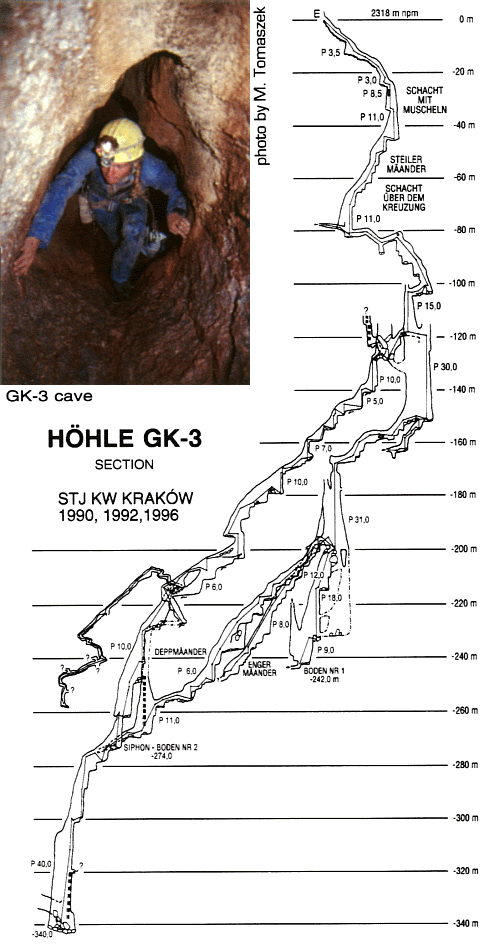THE STEINERNES MEER
- a long way to success
Artur Amirowicz, Maciej Tomaszek
STS KW Krakow
The cavers of STJ KW Krakow became interested in the Steinernes Meer in the late eighties, after a series of unsuccessful expeditions to the Hagengebirge. We looked across the valley and there, in the distance, was what looked like a promised landthe Sea of Stones. But we were yet to learn that reality, as always, is much harsher than dreams.
The Steinernes Meer is one of the largest limestone massifs in the Salzburger Alps. Its plateau has some 200 km2 and is situated at the average height of 2100 m. The best access route leads from the south in the Saalfelden - Maria Alm area. The massif is cut by the German - Austrian border, but nowadays this is not an obstacle.
The first expedition in 1988 was of a reconnaisance character. Two areas were selected for closer inspection - the first one situated on the eastern slopes of the ridge stretching northwards of Breithorn to Weissbachscharte; the second on the north side of a pass between Grasskopf and Leiterkopf. The results of the expedition showed that the second area is much more promising though definitely less accessible. It takes about four hours of tiring walk across the rugged plateau to reach it from Riemannhaus, the last outpost of civilization.
Four other expeditions, in 1989,1990,1992 and 1996, were organized to explore the area. The bivouac was set up in the socalled "Kultur - Biwak", a spacious though uncomfortable cavern in the eastern wall of Wildalmrotenkopf. The remoteness of the area and the scarcity of inhabitable place in the bivouac cave limited the team size and the length of our stay in the mountains. Thus on each occasion there were no more than five cavers and the length of the exploration activity never exceeded two weeks. We had to do as much as possible under such restrictions and, as it turned out, the progress was inevitably slow.
The expedition in 1989 had as its main goal the thorough surface exploration of the area situated between Grasskopf, Leiterkopf and Hochegger. Several small caves were surveyed, the deepest, GK-1 (discovered in 1988) was -72 m.
One promising entrance, marked as GK-2, with strong air draught, was left open. It was the principal target for 1990. The cave ended very soon at -77 m, but this disappointment was quickly forgotten as a new discovery turned our whole attention to another cave - GK-3.
|
Its entrance is situated close to the pass dividing Grasskopf from Leiterkopf, in a steep rock gully, at the altitude of 2318 m. In 1990 the cave was surveyed to -242 m at the bottom of a series of pitches. Three large side meanders were left open - two branching off at -200 m and one at -120 m.
The exploration activity in 1992 was concentrated exclusively on GK-3. We began with the improvement of protection in pitches as bolts were used somewhat sparingly in 1990. Then the most spacious meander was explored but it ended disappointingly at274 m with a small silted syphon. The next side meander terminated at -250 m with a squeeze which we were unable either to penetrate or to widen. The last chance remained at -120 m, in another meander with a small stream. Lack of time allowed us to reach only -160 m, but the problem was still left open.
In the next four years there were some unsuccessful attempts to organize another expedition, but finally in 1996 an almost entirely new team went to the Steinernes Meer. The open meander led back again, through some very nasty squeezes to the syphon at -247 m, but a side passage allowed us to reach a new, more extensive series. The survey was carried out to the depth of 340 m with the measured length of 1188 m, but the cave continues. It was explored to some -400 m where there is a large rift with the stream flowing into a siphon. But a considerable number of side passages left unexplored give good hope for further discoveries.
The expedition also found another promising cave - GK-4. At present it is 50 m deep with the length of 150 m and open for further exploration.
We plan to continue our work in the Steinernes Meer. The obvious target is of course GK-3. But the area still has considerable potential for exploration. And the expeditions to the Steinernes Meer though very difficult are really rewarding.

|
| |

|
























